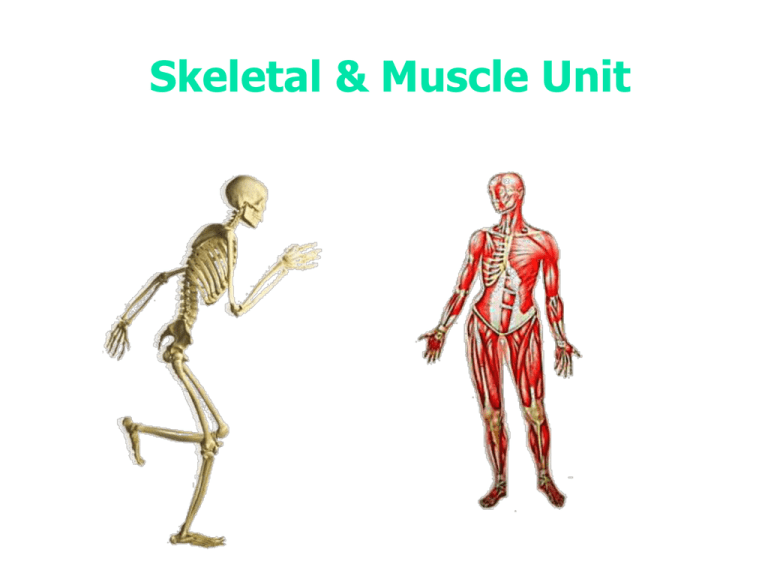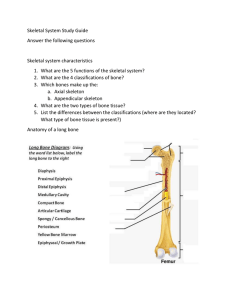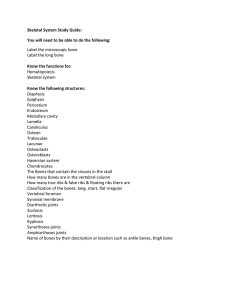Skeletal System
advertisement

Skeletal & Muscle Unit Notes How many bones does the human skeleton contain? 206 Functions of the skeletal system Give shape & support Protect internal organs Moves muscles Form blood cells Store calcium and phosphorous Bone Cross Section Periosteum: soft, thin, covers and protects the bone Compact Bone: Hard, outer surface. Can heal itself when broken Spongy Bone: Porous, contains blood vessels, nerves Marrow: manufactures red blood cells http://www.bmb.psu.edu/courses/bisci004a/bone/fig81.jpg http://www.bmb.psu.edu/courses/bisci004a/bone/bone.htm Skeletal System is divided into two parts Axial Skeleton Skull (protects the brain). Ribs ( protect lungs, and heart). Spinal column (houses and protects the spinal cord). Appendicular Skeleton Legs Pelvis Arms Shoulders Types of Joints Immovable Skull Pelvis Movable Pivot Ball & socket Hinge Gliding http://www.nhfyouthworld.org/junior/mayjun/skeleton.jpg Ball & Socket: Shoulders and Hips Allows arms and hips to move in any direction Can move in a full 360 degrees Pivot Joints: First two neck vertebrae & joint beneath elbow Moves in a semicircle motion by twisting against each other Hinged: Elbows & Knees Move like hinges on a door Limited movement Can only swing back and forth Gliding Joints: Spine, Wrists, Ankles Slide against each other in a gliding motion Gives your wrists and ankles lots of freedom Immoveable joints are located in the: How many muscles do we have? 639 http://www.lifesci.utexas.edu/faculty/sjasper/images/john21.19.jpg http://www.bio.psu.edu/ http://www.bmb.psu.edu/courses/bisci004a/tissues/skeletal.jpg http://www.bio.psu.edu/ http://www.sc.edu/union/Sears/AnimalTissue/im.tissue Cardiac.jpg http://www.bio.psu.edu/ http://www.bmb.psu.edu http://www.sirinet.net/~jgjohnso/ muscle.html Inside a Muscle Muscle Fiber Muscle Myofibril Vocabulary Appendicular The part of your skeleton made up of your arms, legs, pelvis and shoulders. Axial Part of your skeleton that includes skull, ribs, and spinal column. Vertebrae Irregular bones that make up the spinal column Cartilage Smooth tissue that acts as a buffer between bones. Ligaments Tissues that fasten your bones together Calcium The mineral found in bones Periosteum The outer covering of bones. Ball and Socket These joints are found in hips and shoulders. Gliding These joints are found in fingers and the spine. Immoveable This type of joint is found in the skull and is fixed. Pivot These types of joints are found in the head and arms. Voluntary These muscles can be controlled consciously Hinge These joints are found in elbows and knees. Involuntary These muscles can be controlled unconsciously Skeletal Muscle tissue that is attached to bones and causes movement. Smooth This type of tissue lines the walls of many organs and are involuntary. Cardiac Muscle tissue found in the heart. Tendons These tough bands of connective tissue connect bones to skeletal muscles. Strain An injury caused when a muscle is over stretched. Cramp This can be painful and is sometimes caused by too much exercise and not warming up properly. http://www.cytochemistry.net/microanatomy/muscle/smooth1.jpg






